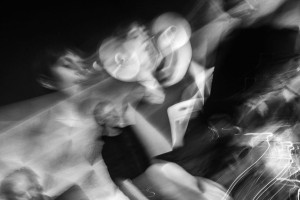 On Friday September 11, 2015, the Curve Line Space Gallery in Eagle Rock was the venue for a concert titled Collaborations 1.1 featuring the works of Gerhard Stäbler and Kunsu Shim as performed by members of the Southland Ensemble. Stäbler and Shim, German experimental composers, are on a three-city tour of the US, sponsored in part by the Federal Foreign Office of Germany and the Goethe Institute. Seven pieces composed between 1986 and 2007 were presented, ranging from conceptual works to those with graphical scores and standard notation. The warm evening and exquisite acrylic paintings by Sue Tuemmler complimented the amiable atmosphere present in the audience and the gallery.
On Friday September 11, 2015, the Curve Line Space Gallery in Eagle Rock was the venue for a concert titled Collaborations 1.1 featuring the works of Gerhard Stäbler and Kunsu Shim as performed by members of the Southland Ensemble. Stäbler and Shim, German experimental composers, are on a three-city tour of the US, sponsored in part by the Federal Foreign Office of Germany and the Goethe Institute. Seven pieces composed between 1986 and 2007 were presented, ranging from conceptual works to those with graphical scores and standard notation. The warm evening and exquisite acrylic paintings by Sue Tuemmler complimented the amiable atmosphere present in the audience and the gallery.
The first piece was by Kunsu Shim In Zwei Teilen – I, and this was performed by violin, viola, cello and recorder. The first notes were barely audible – a light, high arco sound from the cello followed by about a minute of silence. A short chord from the strings and recorder was heard and then another long, soft tone from the cello. The combination of quiet sounds and long silences worked to focus the listening and the result was a sense of keen anticipation. More hushed tones from the cello followed and with a pleasantly dissonant final chord from the strings and recorder, the piece concluded.
Hart Auf Hart by Gerhard Stäbler was next and this had several performers scattered around the floor with portable radios and a graphical score consisting of bar codes overlaid by a grid of numbered coordinates. A series of numbers and letters were called out – much like a bingo game – the performers consulted their scores, and some began tuning their radios. The tuning proceeded fairly rapidly, and short bursts of voices and music were heard as well as loud static. The voices coming from the radios were fragmentary and did not add any sort of narrative. For some performers the score indicated silence, and the radio was turned off. The piece continued in this way, coordinates were called out at intervals and radio sounds were heard coming from different corners of the performance space. All of this produced an interesting texture, if not any definite form. The changing patterns and locations of the sounds produced an intriguing sense of space and movement for the stationary listener. Towards the end of the piece, the performers gathered around an open microphone and all of the radio sounds were now projected from a single speaker, flattening the previous sensations of distance and location. With a burst of loud sounds and static the piece suddenly ended.
The third piece on the program was Gerhard Stäbler’s ]and on the eyes black sheep of night[ for piccolo, clarinet and violin. This was a conventionally notated piece that began with a dissonant tutti chord and gave off a feeling of remote loneliness. The piccolo played two alternating high notes and the others joined in similarly in their registers. The effect was like listening to a clockwork oscillating back and forth with a sort of familiar regularity. The coloring became more intense, adding a bit of anxiety. A sudden and almost painfully loud dissonant chord in the violin and piccolo disrupted the calm and captured everyone’s attention. There was a brief return to the more gentle feeling, but ]and on the eyes black sheep of night[ ended on a second tense chord as if to underline the journey from the comfortable to the anxious.
Luftrand, by Kunsu Shim, followed and this was for violin, viola and cello. Soft, muffled tones – almost a whisper – were heard, followed by silence. The players began each passage together and the quiet chords had a mysterious and secretive feel. Everything was soft and tentative, with never a strong bowing action or loud note. The players exhibited good ensemble and a soft touch to produce the delicate sounds that felt like a series of quiet sighs. Midway through, the string tension on each instrument was reduced and this produced a new sound – less purely musical perhaps, but more evocative. The now-lower notes seemed to be enveloped in a thick fog that greatly added to the mystery. Luftrand with its subtle, muted tones invites a deeper and more rewarding concentration from the listener.